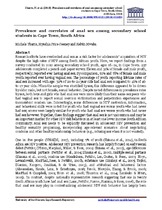| dc.description.abstract | Research efforts have overlooked anal sex as a risk factor for adolescents’ acquisition of HIV despite
the high rates of HIV among South African youth. Here, we report findings from a survey conducted
in 2012 among secondary school youth, ages 16–24, in Cape Town. 937 adolescents completed a
pencil-and-paper survey. Eleven and 31% of female and male youth, respectively, reported ever
having anal sex. By comparison, 59% and 78% of female and male youth reported ever having
vaginal sex. The percentage of youth reporting lifetime rates of anal sex increased with age: 32%
of 20-to-24 year olds had anal sex compared to 16% of 16-to-17-year olds. When the sample was
stratified by sex, this difference appeared to be driven by older male, but not female, sexual
behavior. Despite noted differences in prevalence rates by sex, both boys and girls who had anal
sex were more likely than their same-sex peers who had vaginal sex to report sexual coercion
victimization and perpetration experiences and inconsistent condom use. Interestingly, some
differences in HIV motivation, information, and behavioral skills were noted for youth who had
vaginal sex versus youth who had never had sex; scores were largely similar for youth who had
anal sex versus youth who had never had sex however. Together, these findings suggest that
anal sex is not uncommon and may be an important marker for other HIV risk behaviors in at
least one lower income South African community. Anal sex needs to be explicitly discussed in
adolescent HIV prevention and healthy sexuality programing, incorporating age-relevant
scenarios about negotiating condoms and other healthy relationship behaviors (e.g., refusing sex
when it is not wanted). | en_US |

